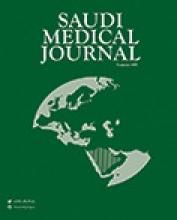Abstract
OBJECTIVE: To study susceptibility of clinical isolates of multi-drug resistant (MDR) Gram-negative bacilli to colistin by minimum inhibitory concentration (MIC) determination using Etest, and compare this with their susceptibility measured by the disc diffusion (DD) method.
METHODS: A total of 224 of MDR organisms (147 Acinetobacter baumannii [A. baumannii], 49 Acinetobacter species, 24 Stenotrophomonas maltophilia [S. maltophilia], and 43 Pseudomonas aeruginosa [P. aeruginosa]) were tested between January 2007 and August 2008 at King Khalid University Hospital, Riyadh, Kingdom of Saudi Arabia. They were identified by standard microbiological methods. Susceptibility by DD and MIC by Etest were interpreted according to the Clinical and Laboratory Standards Institute breakpoints.
RESULTS: Using the MIC method, colistin was found to be active against 100% of Acinetobacter species, 98% of A. baumannii, 84% of P. aeruginosa, and 79% of S. maltophilia. An ascending order MIC90 of colistin was 1 ug/ml for A. baumannii, 1.5 ug/ml for Acinetobacter species, 3 ug/ml for P. aeruginosa, and 16 ug/ml for S. maltophilia. Comparing DD with the Etest method, very major errors of 1.4% were found for A. baumannii and 2.3% for P. aeruginosa, with minor errors of 0.7% for A. baumannii, 8.3% for S. maltophilia, and 11.6% for P. aeruginosa.
CONCLUSION: Colistin was active against most of the MDR isolates tested. The DD method showed significant errors when compared with the Etest method. We recommend using the MIC method to test the susceptibility of MDR Gram-negative bacilli organisms to colistin.
- Copyright: © Saudi Medical Journal
This is an open-access article distributed under the terms of the Creative Commons Attribution-Noncommercial-Share Alike 3.0 Unported, which permits unrestricted use, distribution, and reproduction in any medium, provided the original work is properly cited.






